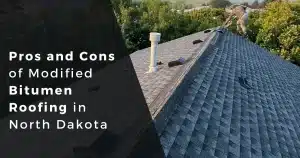Discovering the best roofing option might take time and effort.
Modified Bitumen Roofing often comes up as a contender for homeowners and businesses in North Dakota, particularly in Bismarck and Williston.
This roofing system promises durability and reliability, but is it the right fit for your needs?
Let’s walk through the benefits and drawbacks of Modified Bitumen Roofing to help you make an informed decision.
When choosing a roofing system for your property in North Dakota, you need to consider factors like weather conditions, longevity, and cost. Modified Bitumen Roofing is a popular choice in the region, especially in areas like Bismarck and Williston, known for their varied climates. This roofing type offers unique advantages but also comes with its share of challenges.
It’s a type of asphalt roofing that has been enhanced with modifiers to improve its performance. This system is commonly used for commercial and residential roofs, offering a blend of durability and flexibility. It is available in a variety of forms, including single-ply and multi-ply systems. Understanding these aspects will help you determine if it’s the right option for your roofing needs.
Bitumen Roof Advantages
Durability and Longevity
One of the significant advantages of Modified Bitumen Roofing is its durability. The roofing material is designed to withstand harsh weather conditions, making it a reliable option for North Dakota’s unpredictable climate. With proper installation and maintenance, this Modified Bitumen Roofing System can last between 15 to 30 years. This longevity makes it a cost-effective choice in the long run.
Weather Resistance
North Dakota experiences a range of weather conditions, from heavy snowfall in Bismarck to the occasional summer heat in Williston. This roofing system excels at handling weather extremes. The material is designed to resist water, UV rays, and temperature fluctuations, reducing the risk of leaks and damage. This makes it an excellent choice for regions with severe weather patterns.
Ease of Installation
The installation of a Modified Bitumen Roofing system is relatively straightforward compared to some other roofing options. This can lead to faster project completion and potentially lower labor costs. Additionally, the system is available in both peel-and-stick and torch-down versions, offering flexibility in installation methods.
Energy Efficiency
This type of roofing can contribute to energy savings, particularly if you choose a reflective option. The reflective surfaces can help reduce heat absorption, which may lower cooling costs during the warmer months. This can be a valuable feature for properties in North Dakota, where temperature variations can be significant.
Low Maintenance
Once installed, Modified Bitumen Roofing requires minimal maintenance. The roofing system is resistant to many common issues, such as cracking and blistering. Regular inspections and minor repairs are usually sufficient to keep the roof in good condition, making it a convenient option for property owners.
Drawbacks – Bitumen Roof Disadvantages

Initial Cost
While Modified Bitumen Roofing offers long-term savings, the initial cost can be higher compared to some other roofing materials. This can be a consideration for property owners in North Dakota who are working within a budget. The cost can vary based on factors such as the size of the roof and the specific type of system chosen.
To get a complete understanding of roofing and labor cost you can check our blog on Roofing Labor Cost Per Square: A Comprehensive Guide for Montana, Iowa, North Dakota & South Dakota
Vulnerability to Damage
Although it’s durable, it is not immune to damage. Sharp objects, foot traffic, or severe impacts can potentially cause damage to the roofing material. In areas like Bismarck and Williston, where snow and ice can accumulate, the roofing system may be at risk of damage from ice dams or heavy snow loads.
Aesthetic Limitations
This type of roofing generally offers fewer aesthetic options compared to other roofing materials. The appearance of the roofing system can be somewhat limited, which may not be ideal for property owners who prioritize visual appeal. The focus of this roofing system is more on functionality and durability rather than style.
Installation Challenges
While installation is generally straightforward, certain conditions can pose challenges. For example, extreme temperatures during installation can affect the performance of the Modified Bitumen Roofing system. It’s essential to ensure that installation is carried out by experienced professionals familiar with local conditions in North Dakota.
Environmental Impact
Since it’s made from asphalt, which is a petroleum-based product, this can have environmental implications, particularly in terms of production and disposal. Property owners in North Dakota who are environmentally conscious may want to consider the ecological impact of their roofing choices.
Conclusion
Modified Bitumen Roofing offers a sturdy and reliable solution for property owners in North Dakota, including Bismarck and Williston. While it has its drawbacks, such as higher initial costs and limited aesthetic options, the benefits often outweigh these concerns, especially when considering the roofing system’s durability and performance.
If you’re considering a modified bitumen roofing system for your property, trust the experts at Wegner Roofing to guide you through the process and ensure a quality installation.
Contact us today to learn more about how we can help you achieve a durable and dependable roofing solution.
FAQs
What are the problems with modified bitumen roofing?
Some common problems with Modified Bitumen Roofing include susceptibility to damage from sharp objects, potential challenges with installation in extreme temperatures, and aesthetic limitations. Regular maintenance and careful installation can help mitigate these issues.
What are the disadvantages of a bitumen roof?
The disadvantages of a Bitumen Roof include higher initial costs, vulnerability to damage from impacts or extreme weather, and limited aesthetic options. Additionally, the environmental impact of asphalt-based materials may be a concern for some property owners.
What is the life expectancy of a modified bitumen roof?
The life expectancy of a Modified Bitumen Roofing system is typically between 15 to 30 years, depending on factors such as installation quality, maintenance, and local weather conditions.
What are the advantages of using modified bitumen?Advantages of using Modified Bitumen Roofing include its durability, weather resistance, ease of installation, energy efficiency, and low maintenance requirements. It is particularly well-suited for regions with harsh weather conditions, such as North Dakota.



